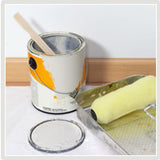 Volatile Organic Compounds (VOCs) are chemicals that evaporate easily at room temperature and pervade our lives in the form of common household cleaners, cosmetics, and DIY supplies.
Volatile Organic Compounds (VOCs) are chemicals that evaporate easily at room temperature and pervade our lives in the form of common household cleaners, cosmetics, and DIY supplies.
VOCs
Volatile Organic Compounds (VOCs) are chemicals that evaporate easily at room temperature. The term “organic” indicates that the compounds contain carbon. VOC exposures are often associated with an odor while other times there is no odor. Both can be harmful. There are thousands of different VOCs produced and used in our daily lives.
VOC Sources:
|
|
Many products emit or “off–gas” VOCs, including:
- Benzene
- Toluene
- Methylene
- Chloride
- Formaldehyde
- Xylene
- Ethylene glycol
- Texanol
- 1,3-butadiene
What are typical VOC levels in the home?
Many studies have shown VOC levels are higher in indoor air than outdoor air. The U.S. Environmental Protection Agency (EPA) Total Exposure Assessment Methodology (TEAM) studies have found indoor VOC levels that were 2 to 5 times higher than outdoors.
Levels of VOC Exposure in indoor air vary widely depending on:
- the volume of air in the room/building
- the rate at which the VOC is off-gassed
- the building ventilation rate
- outdoor concentrations
- time spent in the affected environment
What are the health effects of VOC exposure?
Acute
- Eye irritation / watering
- Nose irritation
- Throat irritation
- Headaches
- Nausea / Vomiting
- Dizziness
- Asthma exacerbation
Chronic
- Cancer
- Liver damage
- Kidney damage
- Central Nervous System damage
Most studies to date have been conducted on single chemicals. Less is know about the health effects of combined chemical exposure. The best health protection measure is to limit your exposure to products and materials that contain VOCs when possible. If you think you may be having health problems caused by VOC exposure, consult an occupational/environmental health physician who specializes in this area.
Are some people at greater risk from VOC exposure than others?
Persons with respiratory problems such as asthma, young children, elderly, and persons with heightened sensitivity to chemicals may be more susceptible to illness from VOC exposure.
How can I tell what levels of VOC are in my home?
Some home screening kits are available to measure total volatile organic compound (TVOC) levels and some individual VOCs. These home sampling kits should be viewed as providing a “ballpark” reading of the amount of VOCs in indoor air. Conditions such as ventilation, temperature and humidity can cause VOC concentrations to fluctuate daily.
Prior to testing, conduct an inspection of your home for some common sources of VOCs such as:
- New carpeting
- New furniture
- Idling automobile in attached garage
- Recent painting
- Chemicals stored in the home
- Recently applied adhesives
- New plastic or electronic devices
Once you determine the probable source of VOCs, steps can be taken to reduce your exposure. If you are unable to determine the source, a professional indoor air quality investigator/industrial hygienist can be consulted.
How do I reduce the levels of VOCs in my home?
Most products containing VOCs will off gas within a short period of time, although some will continue to give off trace amounts of VOCs for a long period of time. The best means of reducing VOC exposure is to eliminate products containing VOCs or use low emitting VOC products.
Some steps you can take to reduce your exposure to VOC in the home are:
- Source control
- Eliminate products from home that have high levels of VOCs
- Purchase new products that contain low or no VOCs (Environmentally Preferable Purchasing)
- Ventilation — open doors and windows, use fans
- Control climate — as temperature and humidity increase some chemicals will off gas more
- Treat the source — airtight sealers can be used to coat over some products. However, caution is advised in choosing the coating product as this could introduce new VOCs into the air while controlling for others.
- Air cleaners — look for ones with activated charcoal filtration designed to remove chemicals from the air.
- Purchasing environmentally responsible cleaning chemicals
- Remove unused chemicals from the home. Check with city or county for household hazardous waste collection sites
View Top 3 Air Purifiers for Chemicals Browse All Air Purifiers for Chemicals

 Volatile Organic Compounds (VOCs) are chemicals that evaporate easily at room temperature and pervade our lives in the form of common household cleaners, cosmetics, and DIY supplies.
Volatile Organic Compounds (VOCs) are chemicals that evaporate easily at room temperature and pervade our lives in the form of common household cleaners, cosmetics, and DIY supplies.